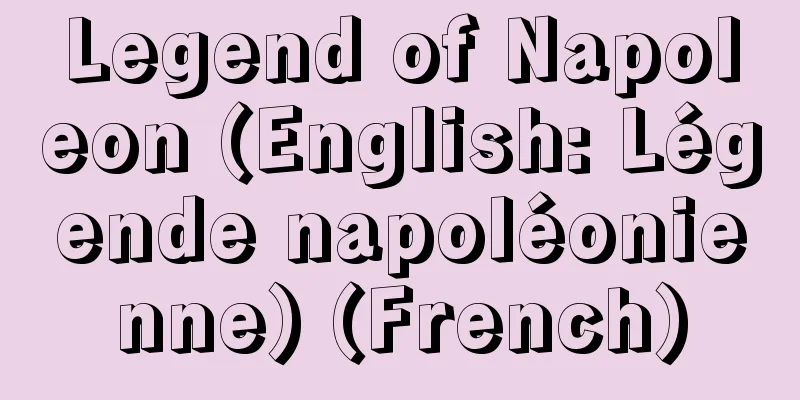Legend of Napoleon (English: Légende napoléonienne) (French)

|
This legend, also known as the Napoleonic myth, celebrates the greatness of Napoleon I and the glory of his empire. Napoleon's heroic existence and dramatic life were legendary not only among writers and thinkers, but also among the general public, and had a major impact on French society throughout the 19th century. [Koji Inoue] Soil of idealizationUnlike ordinary folk legends or heroic legends, Napoleon himself was intentionally involved in mythologizing himself. The soldiers, doctors, and writers who accompanied him to his exile on the island of St. Helena all wrote down his dictations as a daily routine, and these were circulated throughout Europe after Napoleon's death (1821), beginning with Las Cases' (1766-1842) "Memoirs of St. Helena" (1823). This is called St. Helen literature, and in it Napoleon is portrayed as Prometheus, bound to the top of a mountain for giving fire to mankind, a martyr who brings peace to France and Europe, and his military dictatorship is forgotten, making him a peasant emperor and the son of the revolution. The soil that nurtured this idealized image of Napoleon was, first and foremost, the countryside. The majority of Napoleon's army was made up of peasants who had been socially liberated by the revolution and had purchased part of the nationalized land. They not only expected Napoleon to guarantee the results of the revolution, but their memories of running around the continent with the tricolor flag aloft and proclaiming liberty and equality were linked to the glory of Napoleon and the French people. In particular, after Napoleon's fall, when the reactionary rule of the Bourbon dynasty was restored to France, peasants and bourgeoisie alike feared a reversal of the old system, and their admiration for Napoleon as the guarantor of the revolution grew even stronger. Under the July Monarchy, the Bonapartist faction appeared on the political surface, and its focus was Louis Napoleon Bonaparte, nephew of Napoleon I, who later became Napoleon III. [Koji Inoue] Literary influenceMadame de Stael and Chateaubriand, writers who lived in the same era as Napoleon I, were scathing critics of his dictatorship, but writers and poets such as Hugo, Balzac, Stendhal, and Bélanger, who spent their youth during Napoleon's heyday, were also exposed to the literature of St. Helena, and in the climate of mythologizing heroes, they perfected the Napoleon legend in literature. In particular, in the romantic literature of the first half of the 19th century, the longing for the past led directly to the mythologization of Napoleon, and his image took on even greater splendor. This was at the same time that the Bonapartist faction was formed. In Germany, Goethe, who met Napoleon, also spoke of him as a semi-god, Heine could not ignore the Napoleon legend, and Tolstoy, even though he was critical of him, included Napoleon in his works. The extent to which this legend spread throughout the world in the 19th century can be seen from the fact that while Napoleon was still alive, in 1818 (Bunsei 1), Rai Sanyo wrote "Poem of King Horo" in Japan, and many Edo period scholars took a strong interest in him, with more than 10 biographies being written. [Koji Inoue] [References] | |Source: Shogakukan Encyclopedia Nipponica About Encyclopedia Nipponica Information | Legend |
|
ナポレオン1世の偉大さとその帝政の栄光をたたえた伝説で、ナポレオン神話ともいわれる。ナポレオンの英雄的存在や劇的生涯は、文学者や思想家のみでなく、民衆によっても伝説化され、19世紀を通じてフランス社会に大きな影響を与えた。 [井上幸治] 理想化の土壌ナポレオン伝説は、普通の民間伝説や英雄伝説と違って、彼自身が意図的に自身の神話化にかかわっていた。流刑地セント・ヘレナ島まで随伴した軍人・医者・文筆家はいずれも日課として彼の口述を筆記していたが、これらがラス・カーズLas Cases(1766―1842)の『セント・ヘレナの思い出』(1823)を筆頭に、ナポレオンの没(1821)後全ヨーロッパに流布された。これをセント・ヘレナ文学とよんでいるが、そのなかで、ナポレオン像は、人類に火を与えたために山上に縛られたプロメテウスと化し、フランスやヨーロッパに平和を与える殉教者となり、またその軍事的独裁は忘れられて、彼は農民皇帝、革命の申し子ということになる。 このように理想化されたナポレオン像をはぐくむ土壌は、まず第一に農村である。革命によって社会的に解放され、また国有化された土地の一部を購入した農民がナポレオンの軍隊の大部分を占めていたが、彼らはナポレオンが革命の成果を保障することを期待するのみか、三色旗を掲げて大陸を自由と平等を宣布しつつ馳(は)せ回った彼らの追憶は、ナポレオンとフランス国民の栄光とに結び付いていた。とくにナポレオン没落後、ブルボン王朝の反動支配がフランスに復活すると、農民もブルジョアも旧制度への逆転を恐れ、革命の保障としてのナポレオンへのあこがれはいっそう強まった。7月王政下になると、政治の表面にボナパルト派が現れたが、その焦点にたつのがナポレオン1世の甥(おい)にあたるルイ・ナポレオン・ボナパルトで、後のナポレオン3世である。 [井上幸治] 文学への影響ナポレオン1世と同時代の文学者スタール夫人とシャトーブリアンは、彼の独裁に対する痛烈な批判者であったが、その全盛期に青少年時代を過ごしたユゴー、バルザック、スタンダール、ベランジェらの文学者、詩人は、セント・ヘレナ文学にも触れ、英雄の神話化の風土のなかで、文学におけるナポレオン伝説を完成した。とくに19世紀前半のロマン主義文学において、過去へのあこがれは直接ナポレオンの伝説化につながり、ナポレオン像はいっそう光彩を帯びることになった。ボナパルト派が結成されるのと同時期である。ドイツでは、ナポレオンと会見したゲーテも彼の半神のような人間像を語り、ハイネもナポレオン伝説を無視できず、たとえ批判的であっても、トルストイもナポレオンを作品に登場させた。この伝説がいかに19世紀の世界に広まったかは、ナポレオンの存命中、1818年(文政1)日本では頼山陽(らいさんよう)が「法朗王の詩」を書き、江戸時代の学者の多くは強い関心をもち、10冊余りの伝記が書かれたことからも察せられる。 [井上幸治] [参照項目] | |出典 小学館 日本大百科全書(ニッポニカ)日本大百科全書(ニッポニカ)について 情報 | 凡例 |
Recommend
Numinose
...People can feel fear even when the danger is i...
Sagawa [town] - Sakawa
A town in Takaoka County in central Kochi Prefectu...
Kansai
...Typical fish species include herring, pollock,...
Rogers, R.
...The street performers in the square in front o...
Bramante - Donato Bramante
A representative Italian architect and painter of...
"Iberia" (Albeniz) - Iberia
…His works include the opera Pepita Jimenez (1896...
Gas Black
...The microscopic surface state is also differen...
Clogs - Ashida
In modern times, it refers to geta with high teet...
Hartshorn, Richard
Born: 1899 [Died] July 18, 1975. American geograph...
Carnotite
It is an important uranium ore mineral found in s...
Achyranthes fauriei (English spelling) Achyranthesfauriei
… [Tadashi Fukatsu]. … *Some of the terminology t...
"Music of the Change" - Eki no Ongaku
...The use of a kind of chance in music has exist...
Shuttle car
A type of vehicle used to transport ore, rubble, e...
Urakawahara [village] - Urakawahara
A village in Higashikubiki County in southern Niig...
Acute myeloid leukemia
What kind of disease is it? ●Main symptoms and pro...









